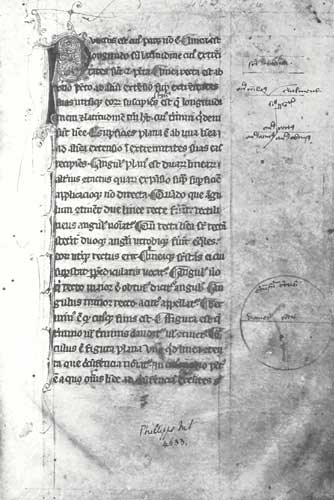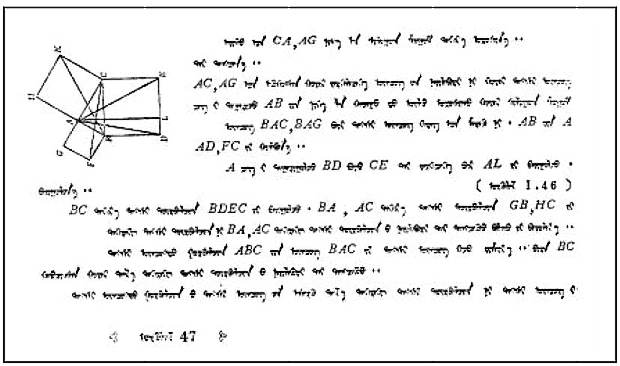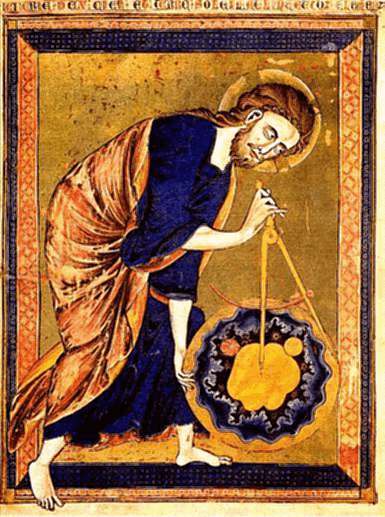.
I never really sat down, like Euclid did for the geometers of Greece, and made sure that you could get it all from a single simple set of axioms. As a result, the work was criticized, I don't know whether favorably or unfavorably, and the "method" was called the "intuitive method". Richard P. Feynman – Nobel Lecture, December 11, 1965

Euclid with Pythagoras Ptolemy and Aristotle (not shown here) in the famous Cathedral at Chartres in France built around 1260 AD http://people.cornellcollege.edu/S-Wilson/
THE BOOK
The mathematician’s patterns, like the painter’s or the poet’s must be beautiful; the ideas, like the colours or the words must fit together in a harmonious way. Beauty is the first test: there is no permanent place in this world for ugly mathematics. Godfrey Harold Hardy (1877-1947) A Mathematician’s Apology
According to the mathematician G. H. Hardy there is no permanent place for ugly mathematics and another great mathematician Paul Erdös therefore had the idea of “The BOOK” in which God maintains the perfect proofs for theorems.
THE BOOK of the BOOKS
The BOOK will be included in the library of Babel of J. L. Borges that contains all books that can be formed by all combinations of all alphabetical symbols. The constraint that each book has 410 pages is not a problem. The library contains books that describe the life of each of us in all details and at all moments, even our future. What is the most important book in this library (The BOOK of the BOOKS)? What information can the library contain? Is something that cannot be expressed in words?
The Elements (Στοιχεία Ευκλείδη) and The BOOK
Euclid's Book Stoicheia, “The Elements”, is considered to be the most important scientific book ever written and probably no other book even in the future will have such an influence for 2000 years and more as science advances today so fast. It is said that after the Bible the Elements was the book with the largest number of copies produced if it is not surpassed someday by the stories of Harry Potter. Actually the number which I have is that the Bible was produced with 2 500 000 000 copies, and then probably follows Agatha Cristie with 2 000 000 000 copies. The Elements, written around 300 BC, has gone through more than 1000 editions since the invention of printing. The Romans were not very much interested in Science if it is not related to Military or Engineering purposes and until 480 AD no copy of the Elements was available in Latin. The Elements were translated into Arabic language almost a millenium after they have written by Euclid and they influenced Arabic mathematics. Indian and Greek books were translated into Arabic and one important center was an academy called the House of Wisdom that was established in the 9th century by the Abbasid caliphs.
The Elements is a book with 13 chapters usually also called books, but in modern terms they are chapters (chapter 1-6: about plane geometry, 7-9: number theory, 10: Eudoxus' theory of irrational numbers , 11-13: solid geometry).

Campanus of Novara, Euclid's Elements, Latin version, c. 1260
Examples of Translations: 1482 Latin version Erhard Ratdolt - first publisher of Euclid , 1543 Italian version translated by Niccolo Tartaglia, 1555 German version (Johann Scheybl), 1565 French version (Pierre Forcadel), 1570 English version (Henry Billingsley), 1576 Spain (Rodrico Zamorano), 1595 first printed version in Arabic, 1774 Swedish version (Märten Strömer).

The first printed edition of Euclid in Mongolian language, translated by Mo De in 1987. (Image from a publication of N. Kastanis)
Euclid's book seems to be a series of axioms, postulates, proofs very strict arranged without any examples and this some have considered was the reason that generations of students had problems in learning mathematics and geometry.
Παρ' Εὐκλείδη τις ἀρξάμενος γεωμετρεῖν, ὡς τὸ πρῶτον θεώρημα ἔμαθεν, ἤρετο τὸν Εὐκλείδη: "Τί δέ μοι πλέον ἔσται ταῦτα μαθόντι;" καὶ ὁ Εὐκλείδης τὸν παῖδα καλέσας "Δός", ἔφη, "αὐτῷ τριώβολον, ἐπειδὴ δεῖ αὐτῷ ἐξ ὧν μανθάνει κερδαίνειν
It is difficult to see how important this book is and even Euclid was asked by a student if he will have some benefit from learning geometry. Euclid is said to have given the student some money so that at least the student could not say that he has no benefit.
Actually very little is known about Euclid and the original version of the Elements. We do not have an original copy and there is an entire science developed of what the original text is and what has been added later. We have only as the oldest known copy a pergament script in the Bodleian Library in Oxford around 888 AD, i.e. 1200 years after Euclid has written the Elements.
It is interesting that many experts of the history of mathematics consider Euclid not a very good geometer, i.e. that he mainly provided a compilation of a part of the accumulated geometrical knowledge. Euclid's Elements appears to be a compendium of Greek mathematics until his times but this is not so. For example the conical sections are not discussed.
The first entry of “The BOOK” is Euclid's proof that the number of prime numbers is not finite.
Proof:
Euclid considers for a set p1,p2,...,pn of prime numbers the number n = p1*p2*...*pn+1 This number has a prime divisor p. But p cannot be any of the p1,p2,...,pn otherwise it would be a divisor of n and and also of p1*p2*...*pn which is impossible. Therefore the set of prime numbers is not finite.

Euclid teaching geometry to his students
The parallel postulate.
Euclid says that two lines are parallel if they never met, even if extended indefinitely in both directions which defines the fifth postulate of Euclid's geometry. While this seems reasonably true Euclid defines this as postulate and not a theorem. Proclus (410-485) believes that this should be a theorem as later Playfair in 1795 who introduces the Playfair axiom: Two lines that intersect one another cannot be both parallel to the same line. Mathematicians tried for 2000 year to modify Euclid's geometry so that the postulate could be proved but they did not succeed.
Out of nothing I have created a strange new universe.
Janos Bolyai (1802-1860), in a letter to his father describing the discovery of non-Euclidean geometry.
Gauss, Bolyai, and Anti-Euclidean Geometry (PDF) (From http://www.larouchepub.com/)
Legendre and others tried to see what happens if the postulate is wrong just in order to find a method to prove that it is correct. And then we had the transition where the postulate was considered to provide possible alternative geometries if it is replaced by another postulate and Gauss, Bolyai and Lobachevsky developed the corresponding theory of non-Euclidean geometry. This does not mean that they showed that Euclidean geometry is wrong but that the postulate is important to define the geometry. If another postulate is used then we have another geometry. With Albert Einstein it becomes clear that matter and space are connected together and the amount of matter defines the geometry. For conditions on our planet the parallel postulate is in practical terms true. Deviations are observed at large scales and or close to large masses that influence the geometry of the surrounding space such as the orbit of the planet Mercury.
The value of non-Euclidean geometry lies in its ability to liberate us from preconceived ideas in preparation for the time when exploration of physical laws might demand some geometry other than the Euclidean.
Bernhard Riemann prophesy about the future when Einstein showed in general theory of relativity that mass influences space-time.

For the Creator, who is the very source of geometry and, as Plato wrote, ‘practices eternal geometry,’ ... Johannes Kepler, “Harmonies of the World”, translated by Charles Glenn Wallis, Great Books of the Western World, Vol. 16, (Encyclopedia Britannica, 1952), pp. 1017-18. Jesus as a Geometer.. The shape of the object he keeps looks like the Mandelbrot set.. and one could say we have Jesus as a Fractal Geometer. The object is actually a deformed view of the Earth and the Ikone is influenced by ancient Greek Geometry and Greek Orthodox Religion. Information for this Image I have: Clark, Kenneth, The Romantic Rebellion. NY. Harper, 1972. p. 52 (http://www.dartmouth.edu/~matc/math5.geometry/unit10/unit10.html )
The Search of the BOOK of the BOOKS
Borges actually does not try to find the BOOK of the BOOKS. He would be happy to know that it exists. “ Let heaven exist, though my place be in hell. Let me be outraged and annihilated, but for one instant, in one being, let Your enormous Library be justified”
Links
The Science of Magnitudes. The Beginnings: The Greeks, Scientists and Artists
Euclid
Selections from Elements, Book I
Selections from Elements, Book V
Selections from Elements, Book VII
Selections from Elements, Book X
Selections from Elements, Book XI
Selections from Elements, Book XII
Very short description of Euclid's Elements
Platonic Polyhedra from Euclid's Elements
Erhard Ratdolt - first publisher of Euclid 1482
Elementorum geometricorum Libri XV 1558 Edition
Byrne's edition of Euclid's Elements , See also http://www.math.ubc.ca/~cass/Euclid/
Elements of Euclid in Greek (from Perseus.. but I would say not easy to use)
Euclid's Fourteenth Book and is there a non-Euclidean Geometry?
Euclid's Plan and Proposition 6
Euclid Greek and English (up to book 9) : http://farside.ph.utexas.edu/euclid/euclid.pdf
See also
M. Aigner, G. Ziegler, Proofs from THE BOOK , Springer, 2000
Geometry: Euclid and Beyond
, Robin Hartshorne, Springer, 2000, Undergraduate Texts in Mathematics
Euclid - The Creation of Mathematics
,Benno Artmann. (New York: Springer-Verlag, 1999).
| Ancient Greece
Science, Technology , Medicine , Warfare, , Biographies , Life , Cities/Places/Maps , Arts , Literature , Philosophy ,Olympics, Mythology , History , Images Medieval Greece / Byzantine Empire Science, Technology, Arts, , Warfare , Literature, Biographies, Icons, History Modern Greece Cities, Islands, Regions, Fauna/Flora ,Biographies , History , Warfare, Science/Technology, Literature, Music , Arts , Film/Actors , Sport , Fashion --- |

